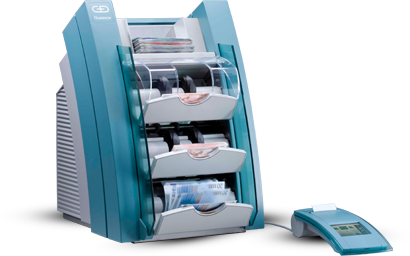Dec 06, 2016 This web page is about GD PCSuite - End User Tool BPS C1 version 3.06.0001 alone. A way to delete GD PCSuite - End User Tool BPS C1 using Advanced Uninstaller PRO GD PCSuite - End User Tool BPS C1 is a program marketed by Giesecke & Devrient GmbH. Some computer users choose to remove it. Jan 26, 2012 With the BPS C1, Giesecke & Devrient (G&D) has added a further robust, high-performance machine to its range of desktop systems. This two-stacker machine, featuring a sorting tray and a reject. In the high-speed processing market, the BPS 1000 from Giesecke & Devrient (G&D), with over 700 system installa-tions, is the undisputed global market leader. The BPS C4 offers top-level security: G&D offers an industry-leading standard when it comes to counting and denomination identification, authentication, and fitness inspection by providing two-sided, full-surface banknote scanning. A separate fail-safe compartment guarantees simple jam recovery with correct accounting. Carl Ludwig Giesecke FRSE (6 April 1761 in Augsburg – 5 March 1833 in Dublin) was a German actor, librettist, polar explorer and mineralogist.In his youth he was called Johann Georg Metzler; in his later career in Ireland he was Sir Charles Lewis Giesecke.
BPS 1000 Course Outline (2 Weeks) June, 2013 Version: A Giesecke & Devrient America, Inc. Page 1 of 10 BPS 1000 Course Outline (2 Weeks) I. LESSON: WEEK 1 / DAY 1 II. BPS 1000 - Service Manuals. Identify the main sections in the. BPS 1000 - Operating Manuals. BPS® C1: Smart, Fast, Robust The compact size and application flexibility of the BPS® C1 banknote processing system enables universal use. It is particularly well-suited for back office use in banks, as well as cash centers and casinos.
Unmanaged Exports
 posted Jul 9, 2009, 9:23 AM by Robert Giesecke [ updated Dec 19, 2012, 12:23 PM]
posted Jul 9, 2009, 9:23 AM by Robert Giesecke [ updated Dec 19, 2012, 12:23 PM] Giesecke & Devrient Systems

Giesecke & Devrient America
Contents
How does it work?Create a new classlibrary or proceed with an existing one. Now you can write any kind of static method, decorate it with [DllExport] and use it from native code. It works just like DllImport, so you can customize the marshalling of parameters/result with MarshalAsAttribute. During compilation, my task will modify the IL to add the required exports. Restrictions
SamplesBasic sampleShowing how to provide an export alias (the name which will be seen from consuming processes) and calling convention. (Default is stdcall, the samples use Cdecl which is used by C/C++) C#:classTest [DllExport('add', CallingConvention = CallingConvention.Cdecl)] { } F#:openSystem.Runtime.InteropServices [<DllExport('add', CallingConvention = CallingConvention.Cdecl)>] static memberTestExport(left : int,right : int) : int = left + right VB.Net:Imports RGiesecke.DllExport PublicModuleTest PublicFunction TestExport(left AsInt32, right AsInt32) AsInt32 EndFunction Marshalling sampleYou can also use the MarshalAsAttribute to control how the marshaller translates your .Net types into native types. The example below shows how to mark a parameter to be returned to native code as an IUnknown-compatible interface reference. btw, this is also how to pass objects between native and .Net ;-) [Guid('Some GUID'), InterfaceType(ComInterfaceType.InterfaceIsIUnknown)] { // without MarshalAs(UnmanagedType.BStr), .Net will marshal these strings as single-byte Ansi! String Name // this is how to add attributes to a getter's result parameter get; // this is how to add attributes to a setter's value parameter set; } public classSample : ISample publicString Name{ get; set; } public int DoSomething(int value) return value + 1; } static classExports [DllExport] public static void CreateSampleInstance([MarshalAs(UnmanagedType.Interface)]outISample instance) instance = newSample{ Name = 'Test' }; } Changes
License Old Downloads removed...The old downloads were removed, please use Nuget. I went pretty far to make those install/uninstall scripts work nicely and undestructively, so please do use them :-) Donation |